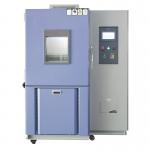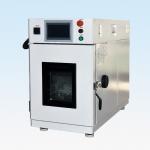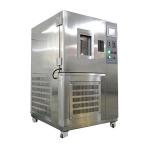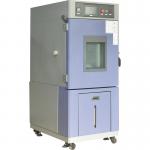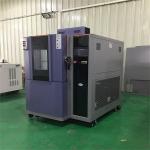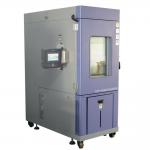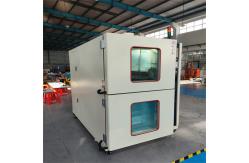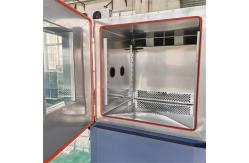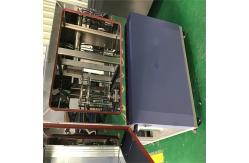In the fast-paced and highly competitive telecommunications
industry, the performance and durability of equipment are crucial.
The custom-designed Climate Chamber Programmable for
Telecommunications Testing is a specialized solution that plays a
vital role in ensuring the reliability of telecommunications
devices and systems. This advanced climate chamber is specifically engineered to create
and control a wide range of environmental conditions for testing
telecommunications equipment. It caters to telecommunications
manufacturers, research institutions, and network service
providers. The primary objective is to evaluate how telecom
devices, such as routers, switches, base stations, and antennas,
perform and withstand different temperature, humidity, and other
climatic variables. By subjecting these components to realistic
environmental stresses, manufacturers can identify potential
weaknesses, optimize designs, and ensure compliance with industry
standards and network requirements. - Robust and Insulated Chamber Structure
- The chamber is constructed with a heavy-duty framework, often made
of high-strength steel or aluminum alloys, to provide excellent
durability and stability. The walls are insulated with high-quality
materials that minimize heat transfer and maintain precise
temperature and humidity levels. The door is designed with a
reliable sealing mechanism and a viewing window, allowing operators
to monitor the testing process without interfering with the
internal environment. The interior is finished with non-conductive
and non-corrosive surfaces to prevent any damage or interference to
the sensitive telecom equipment.
- Precision Temperature and Humidity Control System
- At the core of the chamber's functionality is a sophisticated
temperature and humidity control system. It can achieve a wide
temperature range, typically from -40°C to +80°C, with an accuracy
of ±0.3°C. The humidity control range extends from 5% to 95%
relative humidity, with an accuracy of ±2% RH. The system utilizes
efficient refrigeration units, heaters, humidifiers, and
dehumidifiers, all coordinated by a precise PID controller.
Multiple sensors are strategically placed throughout the chamber to
provide real-time feedback, enabling the control system to make
rapid and accurate adjustments to maintain the desired
environmental conditions.
- Programmable Testing Sequences
- The chamber is equipped with a highly programmable control panel
that allows for the creation and execution of complex testing
regimens. Operators can easily set up temperature cycling, humidity
cycling, and combinations of both, simulating various real-world
scenarios such as seasonal changes, extreme weather events, and
different geographical locations. Additionally, the chamber can be
programmed to introduce other environmental factors like altitude
simulation, dust ingress, and salt spray exposure, providing a
comprehensive evaluation of the telecom equipment's performance and
durability.
- Intuitive Control Panel and Data Acquisition Interface
- The user-friendly control panel simplifies the operation and
parameter setting. It features a clear and intuitive interface that
enables operators to adjust temperature, humidity, test durations,
and other parameters with ease. The control panel also provides
real-time displays of the current environmental conditions, as well
as any alarms or warnings. The chamber is integrated with a
comprehensive data acquisition system that records all relevant
test data, including temperature and humidity histories, rate of
change of environmental parameters, and any observable changes in
the telecom equipment. The data can be stored in a built-in memory
or exported to external storage devices for further analysis. The
system can also generate detailed test reports in various formats,
facilitating easy documentation and sharing of results.
- Safety Features and Alarms
- To ensure the safety of operators and the integrity of the testing
process, the chamber is equipped with a range of safety features.
These include over-temperature and over-pressure protection,
emergency stop buttons, and alarms for abnormal temperature
fluctuations, humidity levels, or equipment malfunctions. The
safety features are designed to prevent damage to the chamber, the
telecom equipment, and the surrounding environment, providing peace
of mind during the testing operation.
- Temperature Range and Accuracy
- With a temperature range of -40°C to +80°C and an accuracy of
±0.3°C, the chamber can subject telecom equipment to a wide
spectrum of temperatures. This is essential for testing the
performance and reliability of devices in extreme cold and hot
conditions, such as in arctic regions or desert environments. The
accurate temperature control ensures that the test conditions are
precisely maintained, providing reliable and repeatable results.
- Humidity Range and Accuracy
- The humidity range of 5% to 95% RH, with an accuracy of ±2% RH,
allows for a comprehensive evaluation of the effect of moisture on
telecom equipment. High humidity can cause condensation and
corrosion, while low humidity can lead to static electricity and
drying of components. The ability to precisely control the humidity
level is crucial for understanding how these devices respond to
different moisture environments.
- Testing Volume and Payload Capacity
- The chamber offers a customizable testing volume, typically ranging
from 1 m³ to 10 m³, depending on the specific model. The payload
capacity can handle a significant amount of telecom equipment, with
a maximum capacity of up to 5000 kg, allowing for the testing of
multiple devices or large-scale network components.
- Data Sampling Frequency and Resolution
- The data acquisition system samples data at a frequency of up to
500 Hz, providing a highly detailed record of the temperature,
humidity, and other environmental parameter changes. The resolution
of the temperature data is 0.1°C, the humidity data is 0.1% RH, and
other relevant data also have high precision. This high-resolution
data is invaluable for identifying even the slightest trends and
potential failure points, allowing for a more accurate assessment
of product performance.
- Accurate Simulation of Environmental Conditions
- The primary function of the chamber is to provide a precise and
reliable simulation of the temperature, humidity, and other
environmental conditions that telecom equipment may encounter. By
subjecting these components to controlled environmental stresses,
it allows manufacturers and researchers to evaluate their
performance and durability. This is crucial for ensuring the
seamless operation of telecommunications networks, as any failure
in the equipment could lead to service disruptions and loss of
connectivity.
- Product Design Optimization and Quality Control
|
